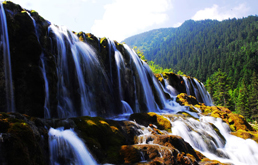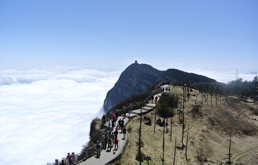Chengdu
Pandas' Hometown
Jiuzhaigou
Famous Fairyland
Emeishan
Sacred Buddhist Site
Leshan
Giant Buddha
Gonggashan
Best for Hiking
Daocheng Yading
Shangri La Views
Dujiangyan
Irrigation System
Siguniangshan
Eastern Alps
The Jinsha Site Museum is a crucial discovery of ancient Shu civilization. The Museum is located at the original archaeological site in at the northwest of Chengdu. This museum is built to preserve and display Jinsha Relics Site, as well as provide an opportunity to study ancient Shu civilization. In 2007, Jinsha Site Museum announced its official opening to the public. The museum covers an area of 300,000 sqm. It consists of a relic hall, an exhibition hall, a center of conservation and restoration, a center of cultural communication and a theme park. Most of the museum’s collections have high value of history, research and exhibition due to its variety in types. Exhibitions of the museum show Jinsha from different aspects of archaeological site, ancient eco-environment, social lifestyle, productions, original beliefs, etc. Jisha Site Museum has been listed as a historical monument and Cultural Relics under state protection. Other titles of this museum include First-class Museum, one of the first Archaeological Site Park and nominee of World Cultural Heritage.
Jinsha Site Museum is located in the west of Chengdu. By taxi it is easy to get to. Bus 5, 7, 82, 83, 84, 96, 111, 123, 147, 163, 403 and 409 pass here.

There are five themes in the exhibition hall, including Primitive Homeland, King Palace at a Glance, Immortal Heaven and Earth, the Sunbird Disk and Seeking Answers to the Mysteries of Jinsha. Over 2000 cultural relics are displayed in different ways to explain the ancient eco-environment, architecture, life and productions, funeral customs, religion and traditions. It brings visitors back to the time of ancient Shu. The design of the exhibition halls allows visitors to revisit any one of the halls.
Relics Hall displays one of the most important excavations of the Jinsha Site, named sacrificial area. On 8th of February 2001, as the first item discovered at Jinsha Site, the sacrificial area revealed the secrets of Jinsha Kingdom. According to the archaeological features and associated artifacts found at this site, the sacrificial area is considered as a ceremonial place located at the riverbank of ancient Shu Kingdom. This area covers about 15’000sqm during 1200 BC to 650BC in late Shang Dynasty to the early Spring and Autumn Time. By far over 60 features and 6000 pieces of items were excavated at this sacrificial are, including the wares of gold, bronze, jade., lacquer, wood and pottery as well as many elephant tusks and boar tusks.
Ebony Forest is located by the southeast of Jinsha Site Museum. It is a display of hundreds of unearthed giant ebonies trunks. The large amounts of ebonies demonstrate a favorable eco-environment in ancient Chengdu.
Sun and Immortal Bird gold ornament is 12.5 centimeter in outer diameter, and 0.02cm’s thick. Its smooth and dynamic pattern is a four immortal birds flying around the sun. It has been regarded as the representation of philosophical theory from the ancient Shu as well as perfect achievement of creative imagination and exquisite craftsmanship. On August 16, 2005, the pattern of Sun and Immortal Bird was used as the symbol of China Cultural heritage
The Sun Festival of Jinsha takes aim at celebrating the Chinese Spring Festival, themed on traditional folk art in forms of colored lanterns, performances, interactive activities. Elements in the Sun Festival are considered as a modern expression of Jinsha Culture and ancient Shu civilization. It is held during Chinese New Year every year.
Entrance Charge: 80 yuan per adult
Opening hours: everyday from 08:00 to 18:00.
ecommended length of visiting: 2 hours
Other interests nearby: Dufu’s Thatched House

Route: Chengdu - Jiuzhaigou

Route: Chengdu - Leshan - Emeishan - Chengdu

Route: Chengdu - Kangding - Gongga - Chengdu